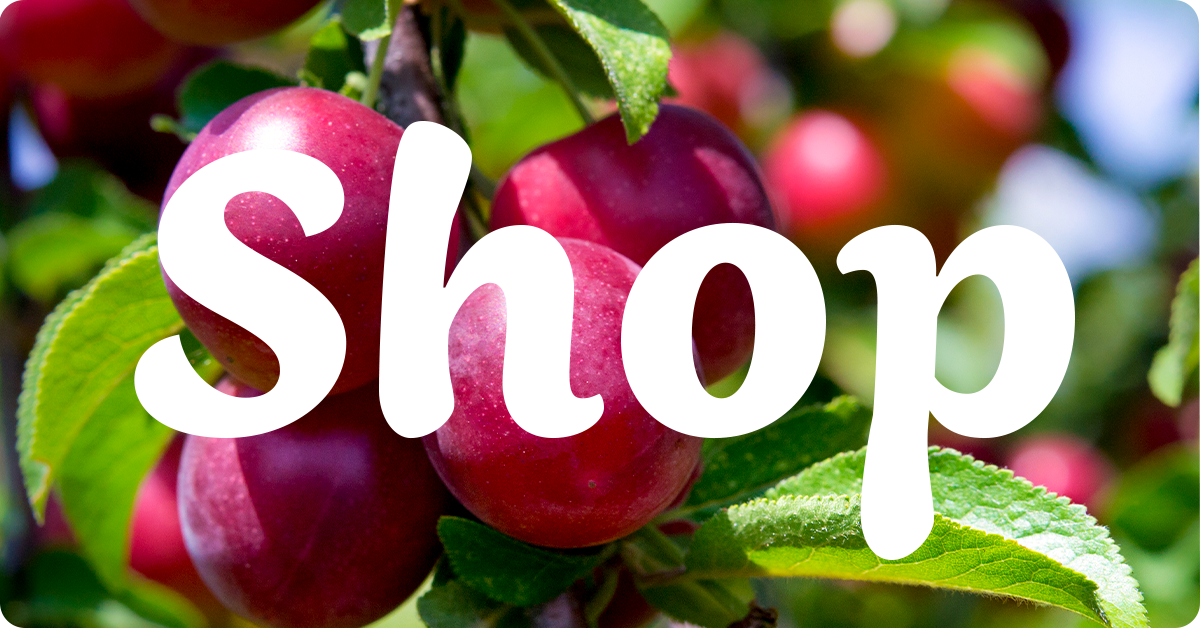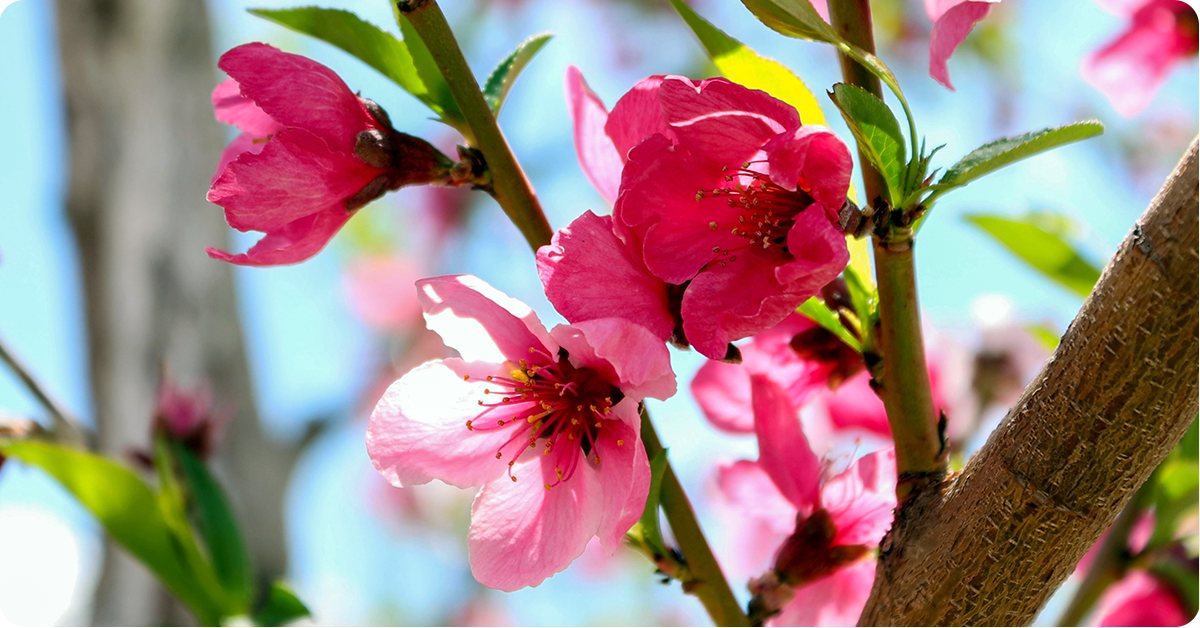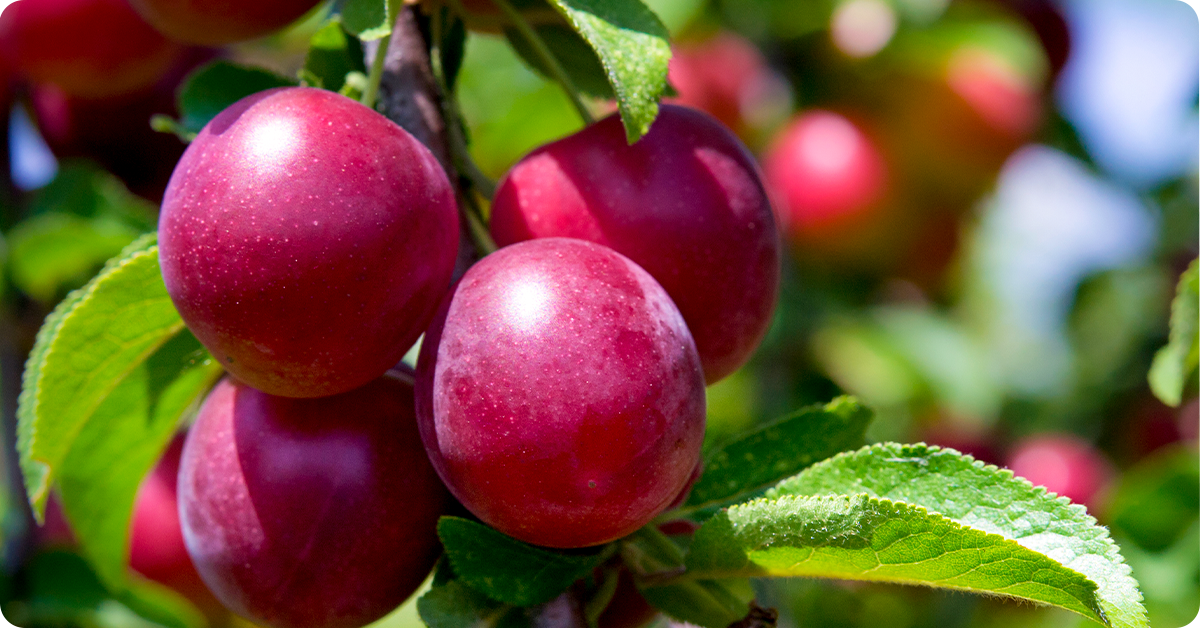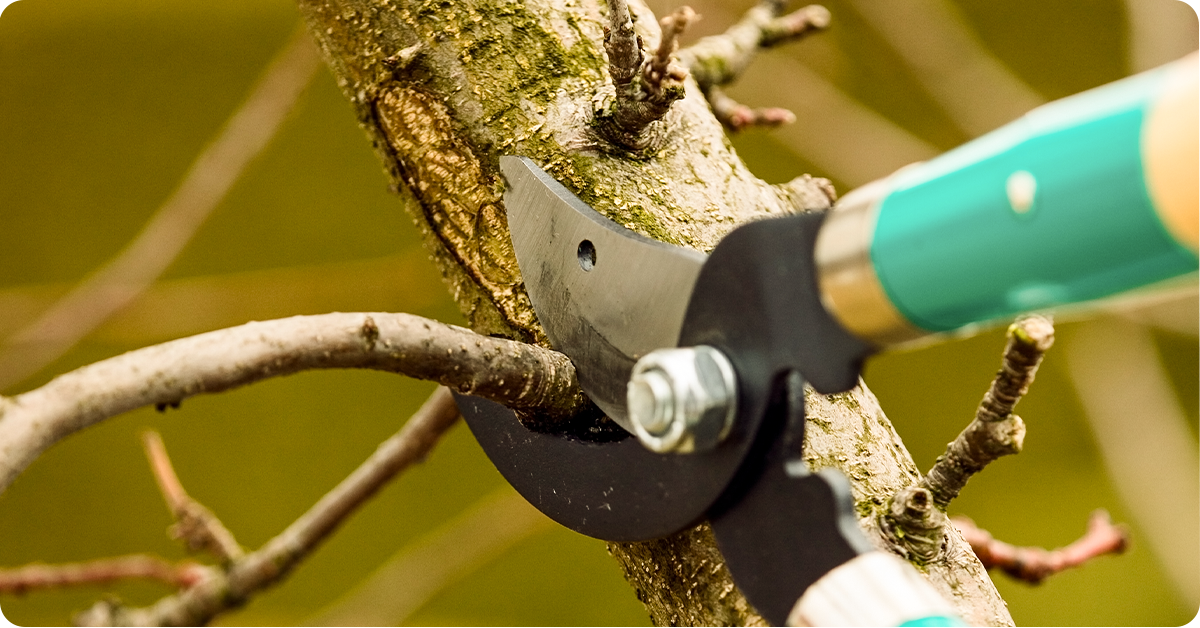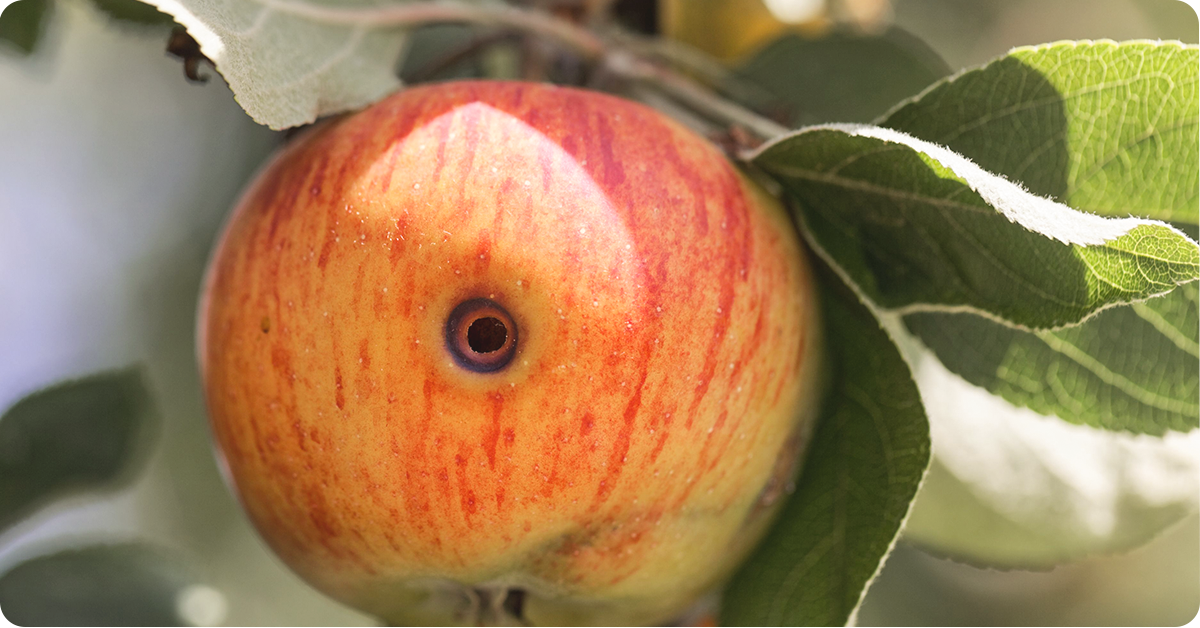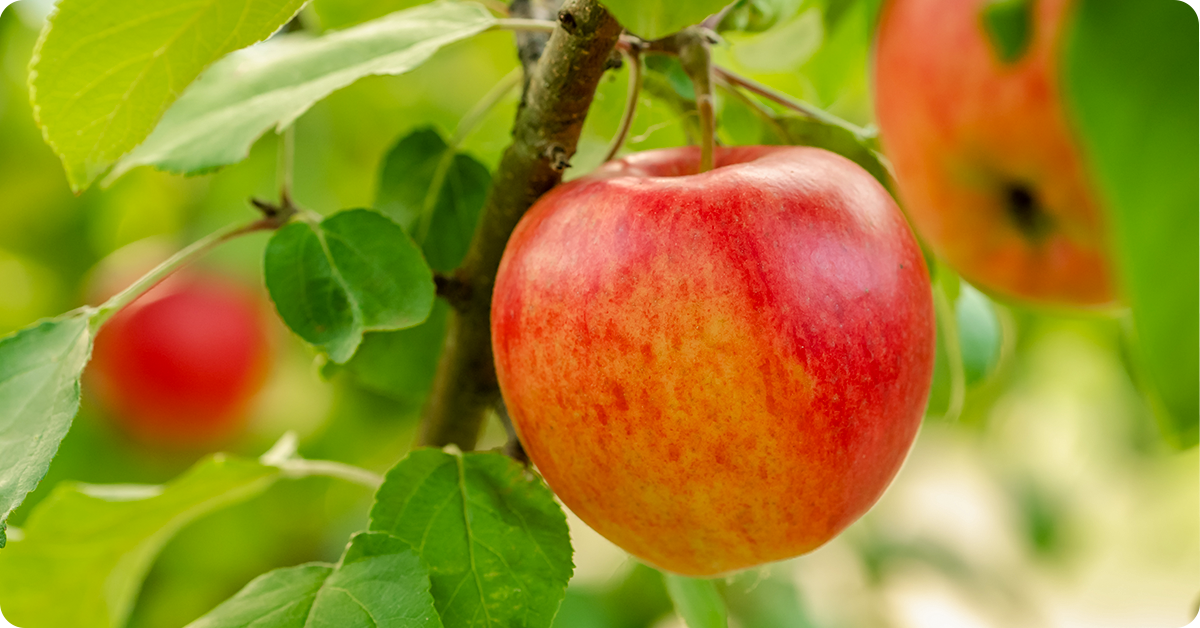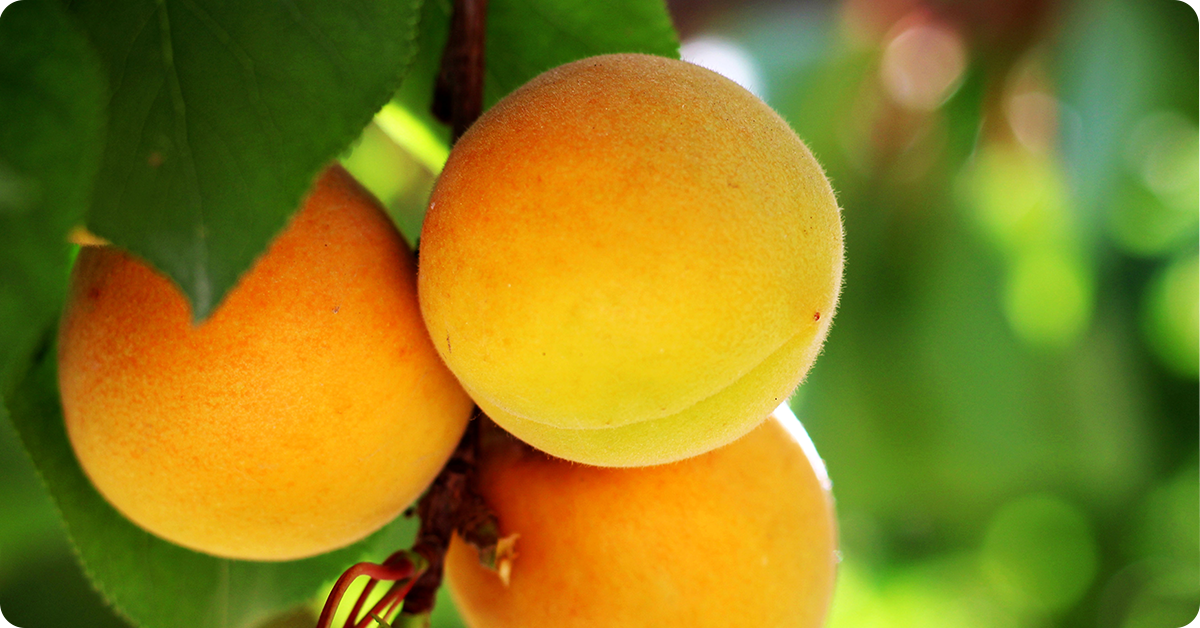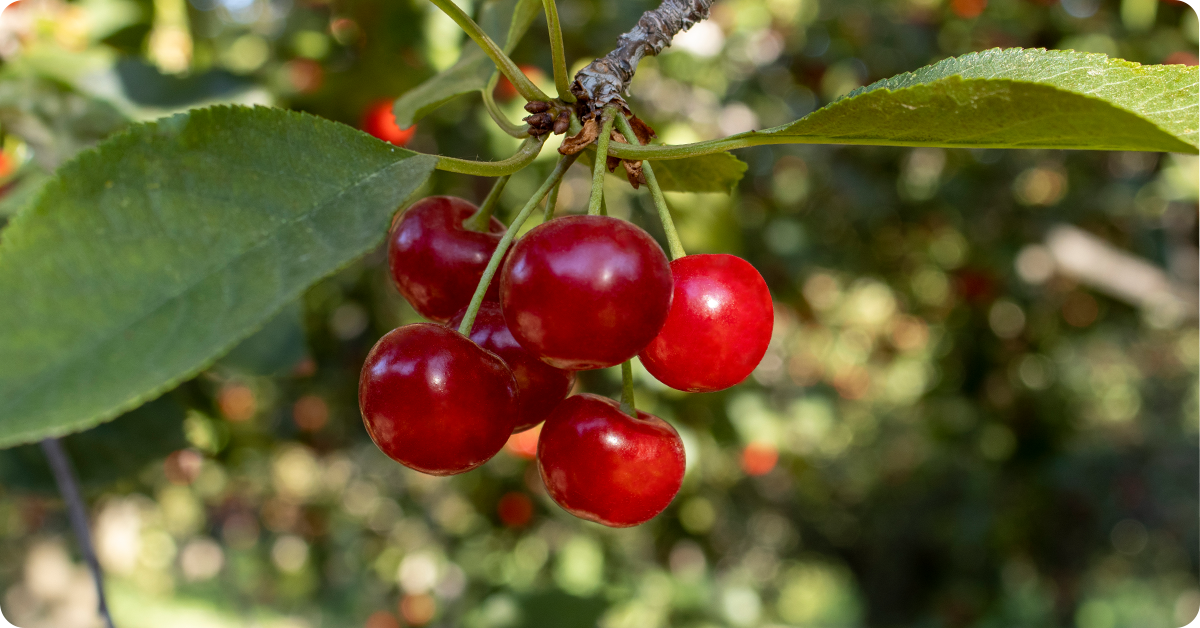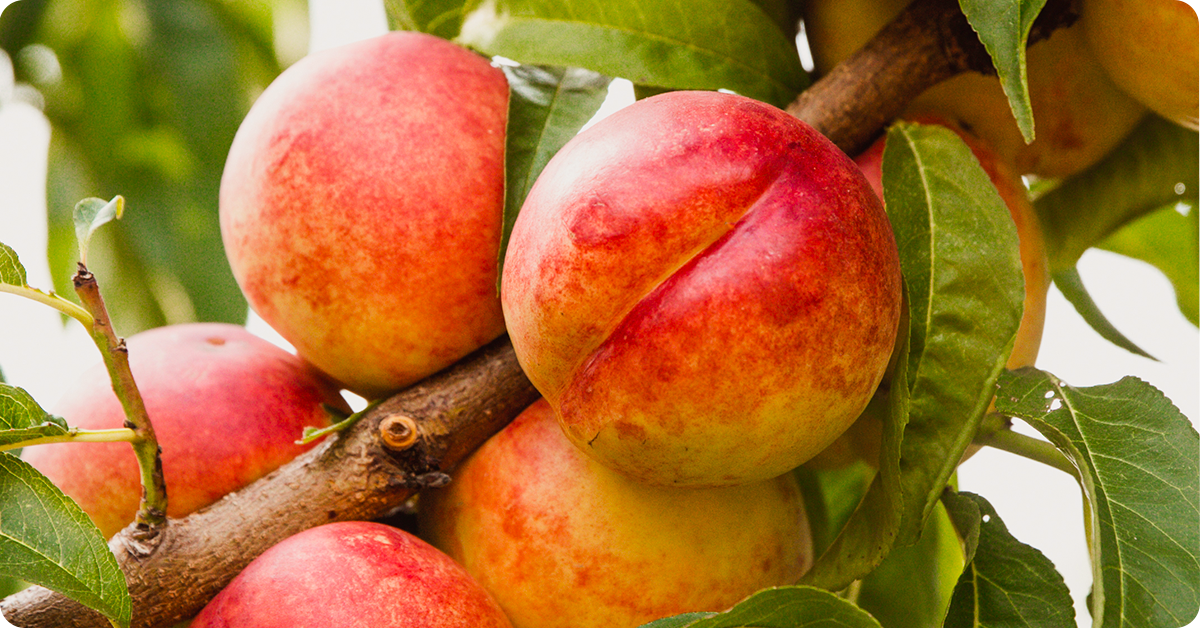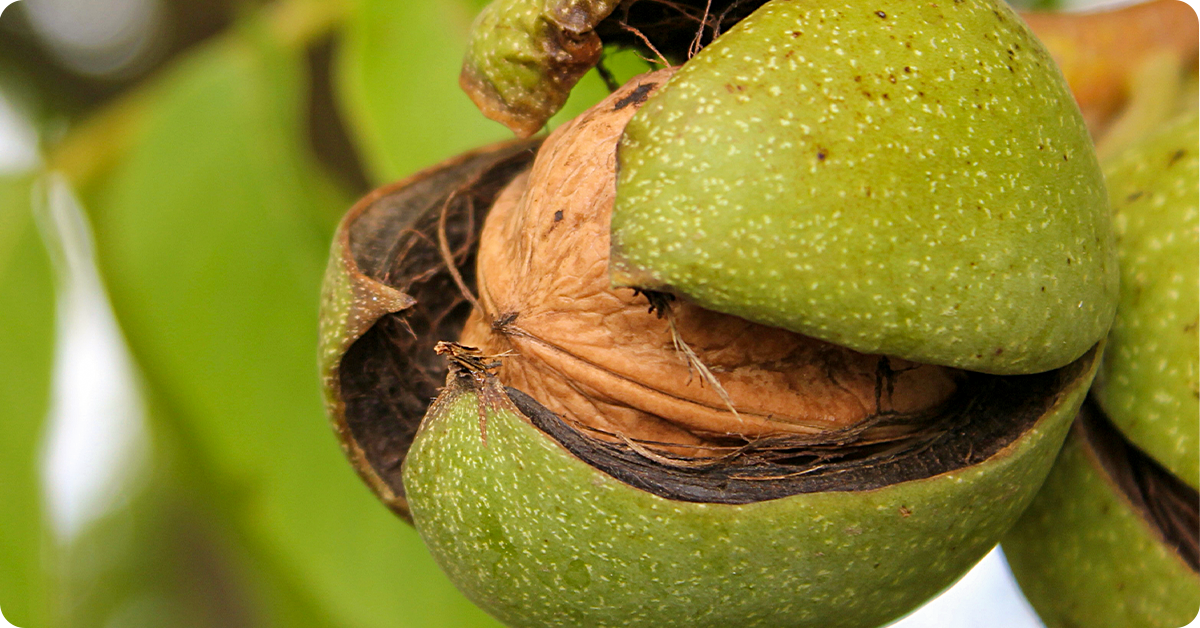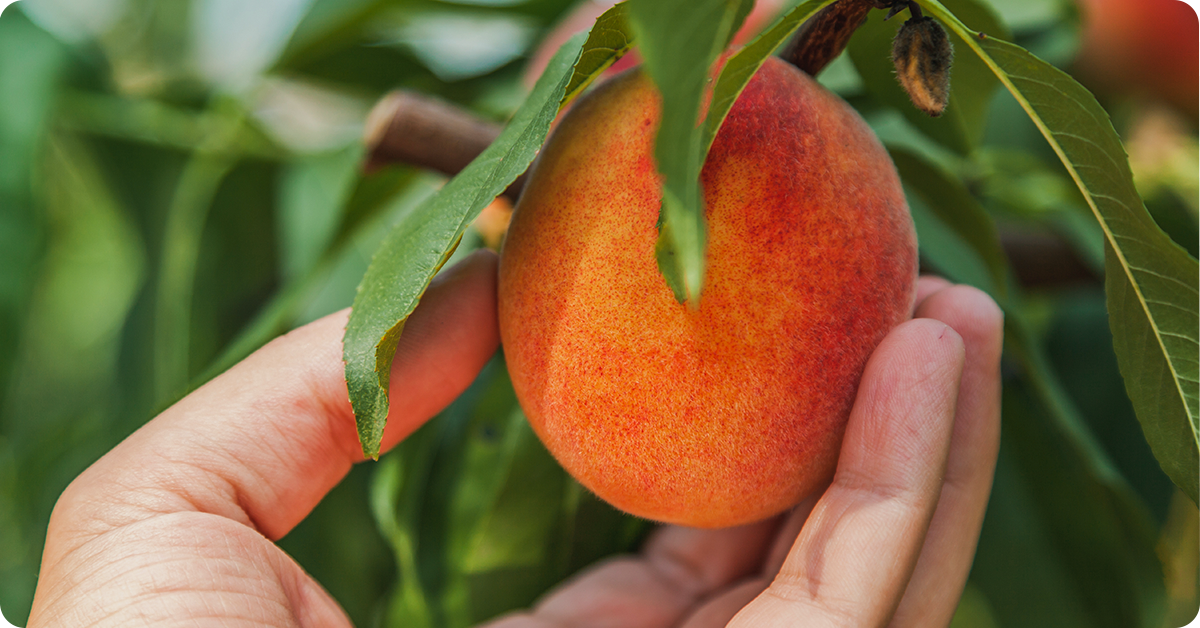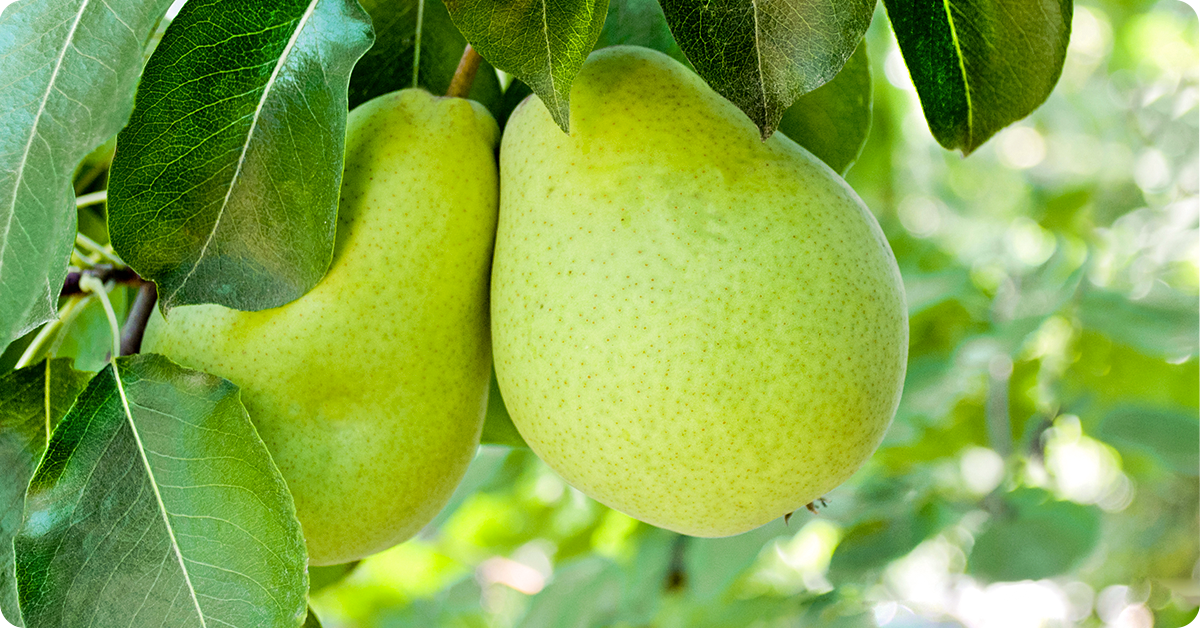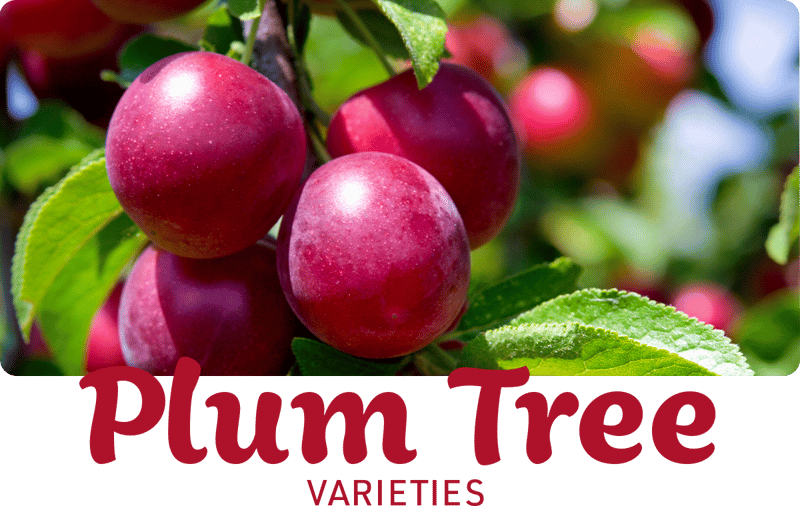
Whether your plums come from a local producer or you grow your own in the backyard, there are so many delicious ways to enjoy these fresh, juicy fruits. IFA plum tree varieties are specially selected for their superb flavor and performance in our intermountain climates, making them ideal for backyard growers and fruit producers. Discover the perfect plum picks that promise bountiful harvests.
Burbank Plum Trees are found nestled in gardens and orchards across the country. These plum trees are not just admired for their beauty but are celebrated for their exceptional fruit production. The Burbank Plum is juicy and sweet with vibrant color. This tree is a resilient and low-maintenance choice for any landscape, offering shade and beauty. Its adaptability to a range of climates and conditions makes it an excellent addition to any Intermountain yard or garden.
Burbank Plums stores well up to three weeks in the refrigerator or on the tree. Be sure to plant with Burgundy, Italian or Santa Rosa plum trees for cross-pollination and fruit-set.
Characteristics:
Tree Height*: 10 feet
Tree Width*: 12 feet
Rootstock: Semi-dwarf
USDA Zone: 4
Fruit Taste: Sweet, tangy & juicy
Fruit Size: Large
Stone Type: Freestone
Fruit Flesh: Red fruit with a golden-orange center
Harvest: Ripens in August
Pollinators: Burgundy, Italian, Santa Rosa
*Tree height and width is based on proper pruning. See growing tips>>
The Burgundy Plum Tree boasts a stunning appearance throughout the year, from its beautiful white blossoms in spring to the deep, rich color of its foliage and fruits in the summer. Not only does it add aesthetic value to any garden, but it also produces delicious, juicy plums that are perfect for fresh eating, baking, and preserves. The Burgundy Plum is known for its adaptability to a wide range of climates and soil types, making it a resilient and low-maintenance choice for gardeners across many regions.
Burgundy Plums store well up to three weeks in the refrigerator or on the tree. Burgundy Plum Trees are self-fertile but plant near Santa Rosa, Toka or Pluot trees for cross-pollination and better fruit-set.
Characteristics:
Tree Height*: 10 feet
Tree Width*: 12 feet
Rootstock: Semi-dwarf
USDA Zone: 5
Fruit Taste: Sweet, mild flavor with tartness
Fruit Size: Medium
Stone Type: Semi-freestone
Fruit Flesh: Maroon fruit with a dark-red center
Harvest: Ripens in August
Pollinators: Self-fertile–for better fruit-set, plant with Santa Rosa, Toka or Pluot fruit tree
*Tree height and width is based on proper pruning. See growing tips>>
Dapple Dandy Pluot Trees, often referred to as "Dinosaur Eggs" due to their distinctive dappled skin, are a delightful addition to any home garden or orchard. Not only are they known for producing fruit that is a unique cross between a plum and an apricot, but they also boast a stunning visual appeal with their beautiful blossoms in the spring. These trees are relatively easy to grow, requiring minimal maintenance once established, and are more resistant to diseases compared to many other fruit trees. Their fruit is highly versatile, perfect for fresh eating, baking, and preserves.
Dapple Dandy Pluots store for well up to six weeks. Plant Dapple Dandy Pluot Trees with Flavor Grenade Pluot or Burgundy and Santa Rosa plum trees for cross-pollination and fruit-set.
Characteristics:
Tree Height*: 10 feet
Tree Width*: 12 feet
Rootstock: Semi-dwarf
USDA Zone: 5
Fruit Taste: Sweet plum-apricot flavor
Fruit Size: Medium
Stone Type: Freestone
Fruit Flesh: Red & purple speckled fruit with a yellow to green center
Harvest: Ripens in September
Pollinators: Flavor Grenade Pluot, Burgundy & Santa Rosa Plum
*Tree height and width is based on proper pruning. See growing tips>>
Gardening enthusiasts and fruit lovers are in for a treat when they choose to grow Flavor Grenade Pluot Trees. The Flavor Grenade Pluot, with its distinctive elongated shape and explosive taste, combines the best aspects of plums and apricots into a single fruit. Imagine biting into the crisp, juicy flesh with a sweet flavor and just the right hint of tartness. This fruit's complex taste profile and refreshing texture make it a standout addition to any home garden.
The fruit keeps well on the tree for three to six weeks. In fact, the fruit becomes sweeter the longer it stays before being picked. Plant Flavor Grenade Pluot Trees with a Dapple Dandy Pluot or Santa Rosa plum tree for cross-pollination and fruit-set.
Characteristics:
Tree Height*: 10 feet
Tree Width*: 12 feet
Rootstock: Semi-dwarf
USDA Zone: 6
Fruit Taste: Explosive flavor & taste test winner
Fruit Size: Medium
Stone Type: Freestone
Fruit Flesh: Green fruit with a red blush and cream-white center
Harvest: Ripens late summer through October
Pollinators: Dapple Dandy Pluot & Santa Rosa Plum
*Tree height and width is based on proper pruning. See growing tips>>
Italian Plum or Prune Trees hold a special place in the hearts of growers for a myriad of compelling reasons. These trees are celebrated not only for their lush, attractive foliage and the beautiful white blossoms but also for their bountiful harvest of delicious fruits. Italian Plums are incredibly versatile with a deep purple skin and sweet, amber flesh that is perfect for fresh eating, baking, canning and drying into prunes. Italian Plum Trees are known for their hardiness, adaptability and resistance to many diseases making them relatively low-maintenance.
Italian Plums store well up to three weeks. Italian Plum Trees are self-fertile but planting near Santa Rosa, Toka or Burgundy trees increases cross-pollination for better fruit-set.
Characteristics:
Tree Height*: 10 feet
Tree Width*: 12 feet
Rootstock: Semi-dwarf
USDA Zone: 4
Fruit Taste: Very sweet
Fruit Size: Large
Stone Type: Freestone
Fruit Flesh: Golden yellow
Harvest: Ripens in August to September
Pollinators: Self-fertile–for better fruit set, plant with Santa Rosa, Toka or Burgundy Plum
*Tree height and width is based on proper pruning. See growing tips>>
Santa Rosa Plum Trees offer not only the delight of mouth-watering fruits but also enhance the aesthetic of any garden with their beautiful blossoms. The Santa Rosa plum variety is particularly noted for its juicy, sweet fruit with a hint of tartness, making it perfect for fresh eating, cooking and canning. Beyond the delicious fruit, the tree itself is a sight to behold, with spring bringing a stunning display of white flowers.Their adaptability to a wide range of climates makes them a versatile choice for many gardeners across the United States.
Santa Rose Plums store well up to three weeks. Santa Rosa Plum Trees are self-fertile but cross-pollination and better fruit-set will occur if planted near Toka, Burbank or Burgundy trees.
Characteristics:
Tree Height*: 10 feet
Tree Width*: 12 feet
Rootstock: Semi-dwarf
USDA Zone: 4
Fruit Taste: Sweet & very flavorful
Fruit Size: Medium
Stone Type: Clingstone
Fruit Flesh: Bright yellow with a deep purple-red skin
Harvest: Ripens in August
Pollinators: Self-fertile–for better fruit set, plant with Toka, Burbank or Burgundy Plum
*Tree height and width is based on proper pruning. See growing tips>>
The Spice Zee NectaPlum Tree is a stunning hybrid that combines the juicy sweetness of nectarines with the tangy flavor of plums, resulting in a fruit that is utterly unique and irresistibly delicious. What sets the Spice Zee NectaPlum apart is not just its impressive aesthetic appeal and mouth-watering fruit but also its hardiness and ease of care. This tree is adaptable to a wide range of climates, resistant to many common diseases and requires less maintenance than many other fruit trees, making it an excellent choice for both novice and experienced gardeners alike.
Spice Zee NectaPlums keep for only three weeks but this fruit variety is NOT available in grocery stores. These trees are self-fertile so start growing your own to enjoy this unique flavor combination.
Characteristics:
Tree Height*: 12 feet
Tree Width*: 8 feet
Rootstock: Semi-dwarf
USDA Zone: 6
Fruit Taste: Juicy, sweet nectarine-plum flavor
Fruit Size: Medium
Stone Type: Freestone
Fruit Flesh: White
Harvest: Ripens in September
Pollinators: Self-fertile
*Tree height and width is based on proper pruning. See growing tips>>
Sweet Treat Pluerry Trees are the perfect fusion of plum and cherry flavors. This hybrid fruit tree offers an exceptional taste experience that is both sweet and juicy, making it a favorite among fruit growers. The distinctive flavor profile of Sweet Treat Pluerry is not the only reason it captivates so many; its ease of growth and bountiful harvests make it a practical and rewarding choice for backyard orchards and gardens.
Sweet Treat Pluerries store well up to four weeks in the refrigerator or on the tree. Be sure to plant with Burgundy, Toka or Santa Rosa plum trees for cross-pollination and fruit-set.
Characteristics:
Tree Height*: 10 feet
Tree Width*: 10 feet
Rootstock: Semi-dwarf
USDA Zone: 5
Fruit Taste: Sweet & tangy flavor similar to cherries
Fruit Size: Small
Stone Type: Clingstone
Fruit Flesh: Bright yellow
Harvest: Ripens in July to August
Pollinators: Santa Rosa Plum, Burgundy Plum, Flavor King Pluot
*Tree height and width is based on proper pruning. See growing tips>>
Toka Plum Trees offer an unparalleled blend of ornamental beauty, delicious fruit and ease of care that makes them a top choice for both novice and experienced gardeners. These trees are renowned for their resilience, thriving in a wide range of soil types and weather conditions, making them a versatile option for many climates. The Toka Plum Tree produces fruit with a distinctive, rich flavor that combines sweetness with a hint of spice for a unique taste.
Toka Plums store well up to three weeks in the refrigerator. Be sure to plant with Burgundy, Burbank or Santa Rosa plum trees for cross-pollination and fruit-set.
Characteristics:
Tree Height*: 10 feet
Tree Width*: 12 feet
Rootstock: Semi-dwarf
USDA Zone: 3
Fruit Taste: Sweet & juicy
Fruit Size: Medium
Stone Type: Semi-freestone
Fruit Flesh: Yellow & firm
Harvest: Ripens in August
Pollinators: Self-fertile–for better fruit set plant with Santa Rosa, Burbank or Burgundy
*Tree height and width is based on proper pruning. See growing tips>>
Self-Pollinating and Cross-Pollinating Fruit
Plum trees are a beloved choice for many gardeners, offering not only delicious fruits but also beautiful spring blossoms. However, for those blossoms to transform into the juicy plums we all enjoy, proper pollination is key. Many plum varieties are not self-pollinating, meaning they require pollen from another plum tree variety to bear fruit. This is where understanding the types of plum trees and their pollination requirements becomes crucial. Some Plum varieties such as Spice Zee NectaPlum and Santa Rosa have the ability to pollinate themselves, but even they can benefit from cross-pollination with another variety, leading to a higher yield. Other plum varieties such as Burbank and Burgundy are reliant on cross-pollination and will need a compatible partner planted nearby.
Improve Plum Harvests
When planning your garden, it's important to research and select varieties that can successfully pollinate each other and to consider their bloom times to ensure they overlap. Proper spacing is also essential to facilitate bee movement between trees, enhancing the pollination process. With thoughtful planning and the right combinations, your plum trees can become prolific producers, offering a bountiful harvest season after season.
Get growing by reading about Backyard Fruit Tree 101, IFA's Growing Guide for Plums, fruit tree pruning tips and insect control for fruit trees. Discover more fruit growing tips by visiting IFA's Helping to Grow Blog.
Backyard Fruit Trees 101 for Growers
Grow your own apples, cherries, peaches and nectarines right in your backyard. Learn how to pick and care for backyard fruit trees Continue >>>
IFA’s Growing Guide for Plums
Grow better, more productive Stone Fruits: Peaches, Cherries, Apricots, Plums and Nectarines Continue >>>
Pruning Different Types of Fruit Trees
Annual pruning improves the overall health and growth of your fruit tree. These simple tips help add years of great fruit production. Continue >>>
Control Common Fruit-Tree Pests
Effectively manage fruit-tree pests with the right tools and knowledge. Discover five common fruit-tree pests and how to control them. Continue >>>
Looking to grow the perfect fruit for you and your family? Discover IFA fruit and nut tree picks perfect for the intermountain west.
*Availability varies by season and location.
